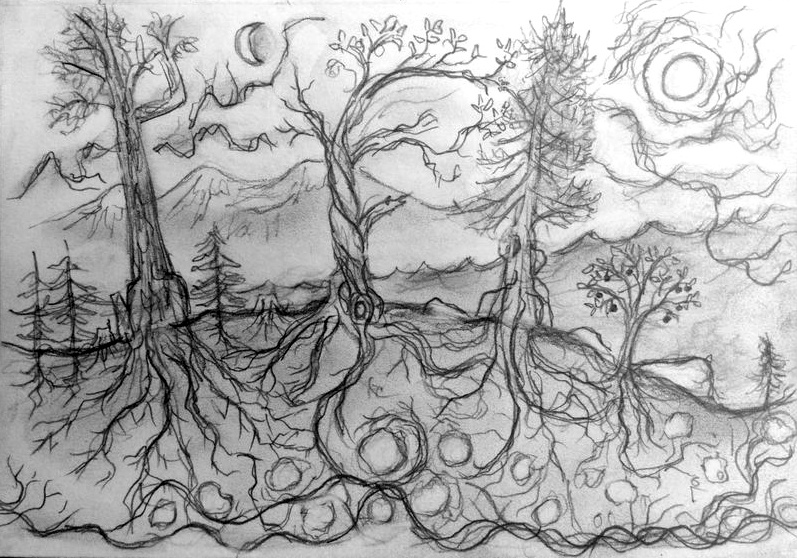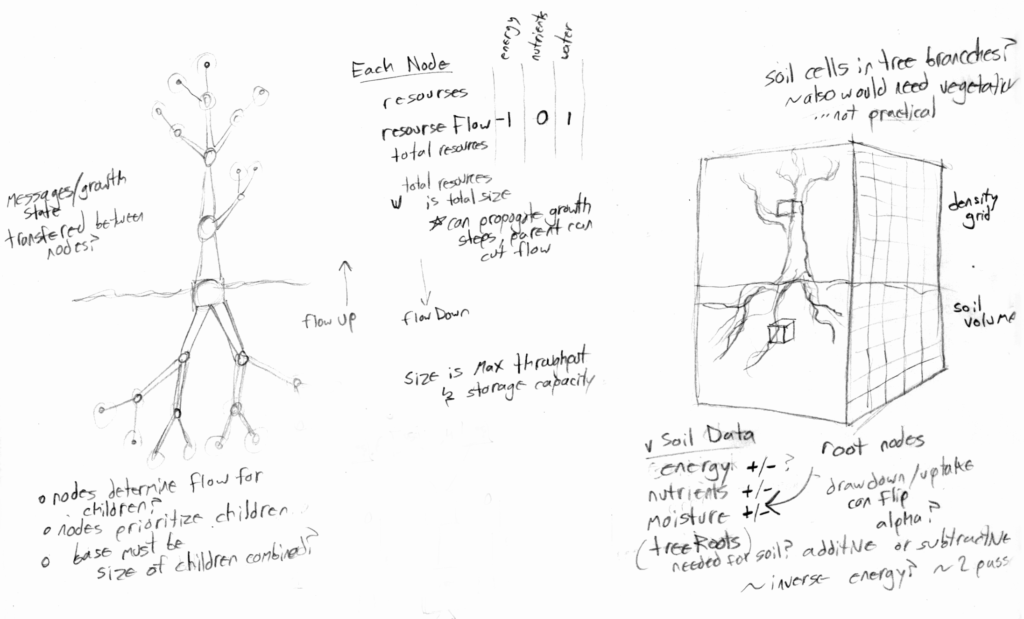Inspiration and Development for Mycelial Forest
Colton Hash
Mycelial Forest is a generative artwork that primarily depicts mutualistic relationships between trees and subterranean fungal networks. I am fascinated by soil ecology, and this experimental project allowed me to explore complex relationships within forest ecosystems.

Mycelial Forest, screenshot, 2023.
Inspiration
As a digital artist, most of my work is necessarily done through a computer. However, I balance my time programming by gardening and hiking through local forests. Through observation and interaction, I am continually learning about ecological systems through personal experience. I strive to be open to emergent thinking as an artist enmeshed within my local landscape, and I can trace inspiration for my art projects to specific moments and places. My creative practice is similarly informed by my relationships with friends, scientists, activists and artists who have shared their knowledge with me.
As a person who grew up in the forests of the Rocky Mountains, I am especially drawn to create art that engages with ecology. Many of my projects consider forest adaptation and resilience amidst climate change, inspired by the pine beetle epidemic and wildfires that I witnessed personally. I have always loved trees, and have long thought of their complex relationships as analogies for societal interactions within human communities. I share forests as a deep source of understanding, inspiration, and spiritual grounding with many others who similarly speak metaphorically about trees. While working on Mycelial Forest, I read Suzanne Simard’s Finding the Mother Tree. Her scientific writing provided me with a framework to understand mutual relationships between trees and fungi, and her personal memoirs affirm the importance of trusting one’s intuition.
As a permaculture gardener, I am particularly drawn to soil building as a regenerative practice. I strive to cultivate a diverse soil ecosystem with organic amendments and low impact cultivation. I see worms, insects and mycelium in my soil as indicators of ecological health. Fruiting mushrooms along woodchip pathways are always a welcome surprise, and are an important metric for evaluating soil diversity. My interest in soil is also informed by an understanding of biochar; inert organic structures created from low intensity burning that supports the growth and resilience of subsurface microbial life.

Resistance and Revitalization, Drawing depicting soil relationships with old growth trees amidst climate change, 2019.
For many years I have thought of old growth trees as indicators of ecological health as well as cultural symbols of settler and indigenous communities. Through their gnarled and mangled forms, I imagine the life history of these elders and wonder about the extremes they have lived through. Spending time amidst old growth Hemlock in the Carmanah Valley, I see how these giants thrive, shed enormous branches and decay as conditions change. When these massive trees fall, they release nutrients, open space for new life and provide structure that can alter the course of powerful rivers. I imagine similar dynamics with their underground roots. When trees have exposed roots at the surface, I see how they spread, intertwine, decay and heal from disturbance. Every tree has a unique life story that depends on how they adapt, share resources and collaborate within their continually changing environment.
Computer Programming
Mycelial Forest is built upon my digital ecosystem model that I developed through my MFA and undergraduate research at the University of Victoria. Through my artistic practice of coding my own software, I create real-time simulations of living systems through approximations of ecological relationships. With parallel processing and efficient data storage and computation, I can create generative landscapes that continually adapt to viewer interaction and evolve to changes in the virtual climate. These digital landscapes allow me to explore complex landscape relationships across large spatial and temporal scales, and to imagine potential futures amidst climate change.

Simplified interaction diagram for Dynamic Landscape System v1, 2021.
Rather than creating predictive scientific models, I am inspired to create interactive simulations that are aesthetically driven and convey key principles of ecological relationships to general audiences. Each landscape is entirely unique as I embrace randomness and unpredictable variation. My practice in creative coding exists within the context of generative art and artificial-life art, employing digital technologies to explore concepts of complexity, adaptation and emergence within virtual spaces.
In my simulation work, I have primarily used GPU-based computation to approximate ecological relationships, where interconnected variables are stored in gridded data structures. Soil nutrients, moisture, microbes and mycelium are represented through a 3D cellular automata system, where each cell changes its state based on its neighboring values. For the foreground trees in Mycelial Forest, I programmed an agent-based system, an entirely different form of processing that is driven by the CPU. Each tree uses a tree-like data structure where individual sections of roots or branches are semi-autonomous entities. Roots exchange energy, nutrients and moisture with the soil, and transmit these resources through a network of connected nodes. Similarly, branches sense each other and gather energy from leaves, providing life to the subsurface roots and mycelium network.

Programming notes for Tree Agent System and Soil Volume, 2023.
To create Mycelial Forest, these Tree Agent and Volumetric Soil Systems were combined with my previous generative ecosystem model. Within this dynamic simulation, changing climate patterns, shifting surface conditions and wildfires affect the old growth trees and underground mycelial networks. Importantly for me, this simulation involves a complex web of interactions that continually evolves, but also exists as a painterly rendering that is expressive and dramatic.
Interactivity
The interactive component of Mycelial Forest is subtle, but allows viewers to enrich the fungal web that enhances tree growth. A digital depth sensor records the movements of viewers in front of the projection, and maps their presence to the volumetric soil data. The number of viewers also influences the rate at which new old growth trees grow, resulting in an ecosystem that reflects cumulative interaction. Mycelial Forest is created as an imaginative exploration of complex relationships between old growth trees and soil organisms amidst a changing climate. I hope to foster space for viewers to consider themselves part of their local environment, and to wonder how they might strengthen ecological relationships both above and below the soil surface.
Research and development of Mycelial Forest is supported by the Canada Council for the Arts.

Bibliography
Mathews, Daniel. Trees in Trouble: Wildfires, Infestations, and Climate Change. Illustrated edition, Counterpoint, 2020.
Mitchell, Melanie. Complexity: A Guided Tour. Illustrated edition, Oxford University Press, 2009.
Simard, Suzanne. Finding the Mother Tree: Discovering the Wisdom of the Forest. Penguin Canada, 2022.
Soler-Adillon, Joan. “Emergence and Interactivity: A-Life Art as a Paradigm for the Creation of Experiences in Interactive Communication.” Hipertext.Net; Núm.: 8 Edició En Anglès, June 2010.
Whitelaw, Mitchell. Metacreation: Art and Artificial Life. The MIT Press, 2006.